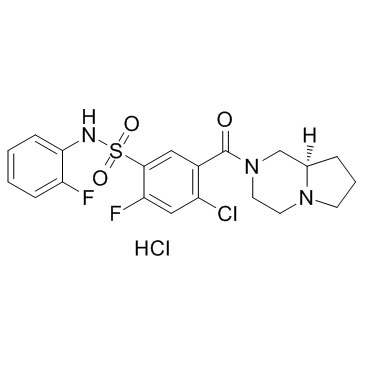1235560-31-2
| Name | ABT-639 hydrochloride |
|---|---|
| Synonyms |
Benzenesulfonamide, 4-chloro-2-fluoro-N-(2-fluorophenyl)-5-[[(8aR)-hexahydropyrrolo[1,2-a]pyrazin-2(1H)-yl]carbonyl]-, hydrochloride (1:1)
4-Chloro-2-fluoro-N-(2-fluorophenyl)-5-[(8aR)-hexahydropyrrolo[1,2-a]pyrazin-2(1H)-ylcarbonyl]benzenesulfonamide hydrochloride (1:1) PNZ74XN2EM |
| Description | ABT-639 hydrochloride is a novel, peripherally acting, selective T-type Ca2+ channel blocker. |
|---|---|
| Related Catalog | |
| Target |
Ca2+ Channel[1] |
| In Vivo | ABT-639 blocks recombinant human T-type (Cav3.2) Ca2+ channels in a voltage-dependent fashion (IC50=2 μM) and attenuates low voltage-activated (LVA) currents in rat DRG neurons (IC50=8 μM). ABT-639 is significantly less active at other Ca2+ channels (e.g. Cav1.2 and Cav2.2) (IC50>30 mM). ABT-639 has high oral bioavailability (%F=73), low protein binding (88.9%) and a low brain:plasma ratio (0.05:1) in rodents. Following oral administration ABT-639 produces dose-dependent antinociception in a rat model of knee joint pain (ED50=2 mg/kg, p.o.). ABT-639 (10-100 mg/kg, p.o.) also increases tactile allodynia thresholds in multiple models of neuropathic pain (e.g. spinal nerve ligation, CCI, and vincristine-induced, and capsaicin secondary hypersensitivity). ABT-639 does not attenuate hyperalgesia in inflammatory pain models induced by complete Freund’s adjuvant or carrageenan. At higher doses (e.g. 100-300 mg/kg) ABT-639 does not significantly alter hemodynamic or psychomotor function. The antinociceptive profile of ABT-639 provides novel insights into the role of peripheral T-type (Cav3.2) channels in chronic pain states[1]. |
| Animal Admin | Rats[1] The pharmacokinetic properties are determined in Sprague Dawley rats dosed intravenously with 5 μmol/kg ABT-639 prepared in 10% DMSO/90% poly ethylene glycol 400 (PEG400). The plasma levels of ABT-639 are determined using HPLC and mass spectrometry. Following oral administration (p.o.) of the ABT-639 (3, 10 and 30 mg/kg) prepared in 10% PEG400/10% Cremophor EL/80% Oleic Acid the levels of ABT-639 in plasma and brain are determined. Briefly, the brains are immediately removed and freed from blood vessels as much as possible. The resulting brain tissues are frozen at -20°C, followed by weighing and homogenization before analysis. The heparinized blood samples are also frozen (-20°C) until analysis. ABT-639 is separated from the blood and brain samples using protein precipitation with acetonitrile followed by quantification with liquid chromatography/mass spectroscopy. Plasma samples for concentration determinations from in vivo efficacy experiments are collected from each animal within 15 min following behavioral testing. |
| References |
| Molecular Formula | C20H21Cl2F2N3O3S |
|---|---|
| Molecular Weight | 492.367 |
| Exact Mass | 491.064880 |
